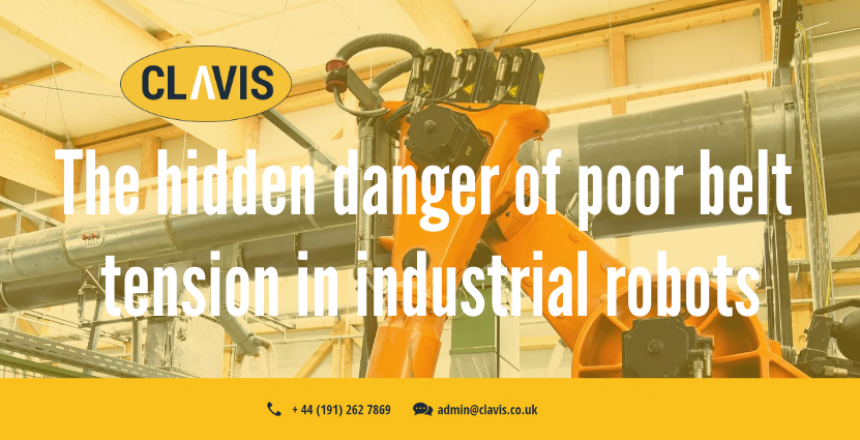When you have driven your car for a year, or for 12,000 miles, you know it needs a service, right? It’s second nature to take it to the garage and have a mechanic ensure it is in perfect condition.
But did you know you should provide the same scheduled care for an industrial robot? FANUC recommends a service every 3,850 hours of run time, or every 12 months, while KUKA suggests essential maintenance every 5000 hours. Unfortunately, many maintenance engineers are not aware of this and others do not recognise the hidden danger of inadequate robot servicing — poor belt tension checks.
Most MRO (Maintenance, Repair and Operations) professionals in industry understand the basics of robot maintenance, such as backing up memory, visual inspection and greasing the joints, bushings and balancer. However, maintaining the belt drives, which are common on the third axis of six axis robots, in wrist actuators and in cartesian robots, is a darker art.
Robot manufacturers usually select belt drives on parts of a robot that might not require the accuracy of a strainwave gear. They do so to reduce the overall cost of manufacture and, as a result, the price and total cost of ownership over a robot’s its lifetime.
However, belt drives on robots suffer from several core upkeep issues — overheating, contamination, improper loading, everyday wear of mechanical components and incorrect initial installation or re-installation after maintenance. If these core issues are not addressed, that total lifetime cost could spike.
In this article, I explain the re-installation of the belt drive, but it is an interconnected problem. Normally, if the drive is being reinstalled, it is because it has been removed to allow maintenance that counters one of four other common problems.
Reinstallation of an industrial robot belt drive
Improper belt tension is the most common problem when a belt is reinstalled after maintenance, and its consequences can be worse than the problem you corrected in the first place!
Belt drives on robots are usually tensioned by adjusting the centre to centre distance between the pulleys or via a tensioner/idler pulley. They can deliver very low backlash and up to 98 per cent efficiency — providing the tension is correct.
However, a better methodology of establishing tension is to use a handheld instrument that is designed for exactly this job. Just like a robot should be serviced a regularly as a car, a robot belt drive should be treated with as much, if not more, precision and care as the handbrake or serpentine belt in a vehicle.
The Clavis handheld meter uses vibration in the belt to determine tension, by gently plucking or tapping it. As the tension in the belt increases, so does the frequency of the vibration. Our system can feature two different types of sensor — either a patented acoustic unit or an optical sensor. The meter then displays the result in Hertz, Newtons, pounds-force or KgF.
The acoustic sensor is ideal for belts that vibrate poorly or where the amplitude of the vibration is small. The optical unit is perfect when there is a physical restriction because it doesn’t require contact and takes measurements from up to 50mm away.
The most selected units are the Type 3 (Optical) belt meter, which can measure tension from 7Hz to 300 Hz and the Type 7 unit, which measures from 10Hz to 600Hz. On the Type 3 belt meter, the sensor can direct a beam onto the flat side of the belt, either the outer faces or pulley contact face, from distances of 5-15mm, although in most cases, readings may be taken from distances up to 50mm. The Type 7 can be fitted with either an optical or acoustic sensor head. This video illustrates how simple they are to use in practice.https://www.youtube.com/embed/faQV_B1_7kI
The consequence of poor re-installation
Improper belt tension can cause increased friction on the belt, which generates heat that can further damage the belt drive. It could even cause the belt to become misaligned, which makes it hard to maintain proper tension, creating a vicious circle.
That increased friction is nothing more than an expression of energy being turned into heat, which means the electrical and carbon requirements of the application are increased. This might not seem like a big issue but imagine a plant with dozens of lines and dozens of robots on each line. In this environment, the cost will mount up very quickly.
The additional wear on motors created by poor tension and misalignment, and the additional power required to generate all that heat you are expressing as friction, will also lead to electric motor maintenance problems eventually.
The catch with servicing an industrial robot is that, unlike your car, nobody will remind you to do it. There will be no irritating stream of letters, text messages and phone calls from your garage, urging you to book in as soon as possible. You certainly do not need an MOT to keep using it.
If you have a maintenance relationship with your manufacturer, or with an independent robot servicing company like CNC Robotics, Kontroltek or RobotWorx, then you may well be reminded. Many robots, such as the KUKA model I referenced earlier, also feature built in maintenance logs and records, but this is certainly not true on older units.
If you complete your robot maintenance in house, it would be wise to create a checklist featuring everything from replacing controller batteries to checking cable connections. And, when you do, make sure you include a belt tension check. Your mechanic would not forget the equivalent on your car, after all.
Article by Andrew Punton

